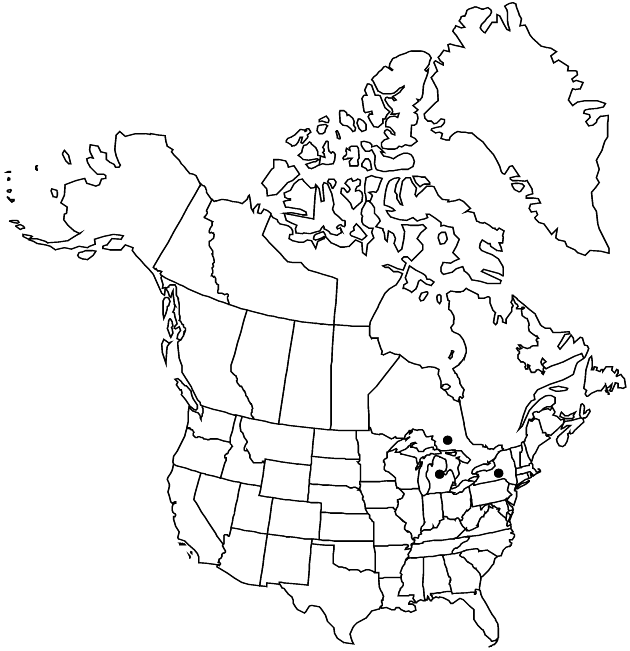Difference between revisions of "Solidago houghtonii"
in A. Gray, Manual, 211. 1848.
FNA>Volume Importer |
imported>Volume Importer |
||
| (One intermediate revision by the same user not shown) | |||
| Line 1: | Line 1: | ||
{{Treatment/ID | {{Treatment/ID | ||
|accepted_name=Solidago houghtonii | |accepted_name=Solidago houghtonii | ||
| − | |accepted_authority=Torrey & | + | |accepted_authority=Torrey & A. Gray |
|publications={{Treatment/Publication | |publications={{Treatment/Publication | ||
|title=in A. Gray, Manual, | |title=in A. Gray, Manual, | ||
| Line 8: | Line 8: | ||
}} | }} | ||
|common_names=Houghton’s goldenrod | |common_names=Houghton’s goldenrod | ||
| + | |special_status={{Treatment/ID/Special_status | ||
| + | |code=E | ||
| + | |label=Endemic | ||
| + | }} | ||
|basionyms= | |basionyms= | ||
|synonyms={{Treatment/ID/Synonym | |synonyms={{Treatment/ID/Synonym | ||
| Line 44: | Line 48: | ||
-->{{#Taxon: | -->{{#Taxon: | ||
name=Solidago houghtonii | name=Solidago houghtonii | ||
| − | |authority=Torrey & | + | |authority=Torrey & A. Gray |
|rank=species | |rank=species | ||
|parent rank=section | |parent rank=section | ||
| Line 57: | Line 61: | ||
|publication title=in A. Gray, Manual, | |publication title=in A. Gray, Manual, | ||
|publication year=1848 | |publication year=1848 | ||
| − | |special status= | + | |special status=Endemic |
| − | |source xml=https:// | + | |source xml=https://bitbucket.org/aafc-mbb/fna-data-curation/src/2e0870ddd59836b60bcf96646a41e87ea5a5943a/coarse_grained_fna_xml/V19-20-21/V20_362.xml |
|tribe=Asteraceae tribe Astereae | |tribe=Asteraceae tribe Astereae | ||
|genus=Solidago | |genus=Solidago | ||
Latest revision as of 20:02, 5 November 2020
Plants 30–60+ cm; caudices branching; vascular bundles and petiole bases marcescent (attached to old stems for more than a season). Stems 1–5+, erect, slender, glabrous. Leaves: basal tapering to long, winged petioles, blades ovate, to 7–22 mm wide, margins entire, apices acute, faces glabrous; proximal cauline tapering to winged petiole-like bases partially clasping stems, blades sometimes 3-nerved (2 prominent lateral nerves arising proximally and running alongside midnerve for some distance before diverging), linear oblanceolate, 158–177 × 7–22 mm, margins entire, ciliate, apices acute to obtuse, glabrous; mid to distal sessile, blades linear lanceolate, mid often 3-nerved (obscurely sometimes), distal 1-nerved, 47–100 × 4–10 mm, reduced distally. Heads (2–)5–50(–100+), not secund, in corymbiform arrays, branches and peduncles glabrous or moderately strigillose. Peduncles 5–6.2 mm, sparsely to moderately strigillose; bracteoles 0–2, linear. Involucres campanulate, (5.5–)6–8(–9) mm. Phyllaries in 3–4 series, unequal, linear to oblanceolate, margins ciliate, weakly striate, obtuse to rounded. Ray florets 6–12 (pale to bright yellow); laminae 7.4–7.9 × 0.5–0.6 mm. Disc florets 8–15; corollas 4–4.3 mm, lobes 0.9–1.5 mm. Cypselae obconic, 1.4–1.8 mm, glabrous, ribs sometimes dark; pappi of bristles 4–5.5 mm, clavate. 2n = 54.
Phenology: Flowering Aug–Sep.
Habitat: Damp, interdunal hollows, limestone pavements (alvars)
Elevation: 100–400 m
Distribution

Ont., Mich., N.Y.
Discussion
The large involucres and the presence of the unique 3-nerved proximal and mid cauline leaves distinguish Solidago houghtonii from other taxa in sect. Ptarmicoidei. The 3-nerved venation pattern may be morphologic evidence of a hybrid origin for S. houghtoni between a parallel-nerved member of sect. Ptarmicoidei and a 3-nerved member of subsect. Triplinerviae. Molecular data indicate that S. gigantea may have been one of the parental species (P. Laureto, pers. comm.).
Reports of Solidago houghtonii from New York have been rejected as being based on misidentified specimens (J. K. Morton 1979). Some collections have the large involucres typical of S. houghtonii; molecular data indicate that the species is present in Genessee County, New York (P. Laureto, pers. comm.).
Solidago houghtonii can be difficult to distinguish from S. ohioensis × S. ptarmicoides hybrids because both have hairy peduncles in arrays. The hybrids have pale yellow rays even when fresh; post-flowering rays of S. houghtonii can be pale yellow. J. K. Morton (1979) hypothesized an allopolyploid origin for the hexaploid S. houghtonii via an unreduced gamete of S. ohioensis × S. ptarmicoides backcrossed to S. ohioensis with subsequent chromosome doubling. Additional work is needed to confirm this hypothesis. An aberrant collection (M. R. Penskar 1067, MICH) had about 400 heads (mostly in bud) due to axillary branches developing along nearly the entire stem; stems usually have fewer than 50 heads. Some plants from Michigan are more robust than those found in Ontario.
Solidago houghtonii is listed by the U.S. Fish and Wildlife Service as threatened in Michigan. It is in the Center for Plant Conservation’s National Collection of Endangered Plants.
Selected References
None.